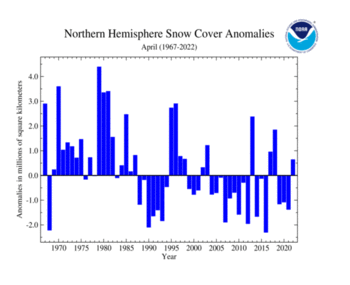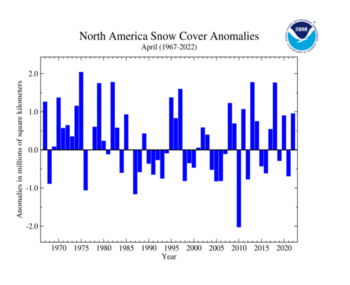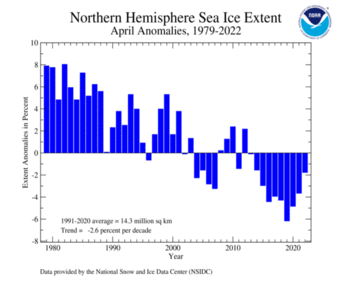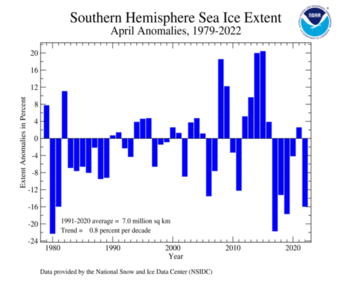NH Snow Cover Extent
| April 2022 | Snow Cover Extent | Anomaly 1991-2020 | Trend per decade | Rank (56 years) | Record | ||||||
|---|---|---|---|---|---|---|---|---|---|---|---|
| million km² | million mi² | million km² | million mi² | million km² | million mi² | Year(s) | million km² | million mi² | |||
| Northern Hemisphere | 30.86 | 11.92 | +0.93 | +0.36 | -0.40 | -0.15 | Largest | 23rd | 1979 | 34.61 | 13.36 |
| Smallest | 34th | 2016 | 27.91 | 10.78 | |||||||
| North America | 13.99 | 5.40 | +0.82 | +0.32 | -0.06 | -0.02 | Largest | 13th | 1975 | 15.08 | 5.82 |
| Smallest | 44th | 2010 | 11.02 | 4.25 | |||||||
| Eurasia | 16.86 | 6.51 | +0.10 | +0.04 | -0.34 | -0.13 | Largest | 32nd | 1981 | 20.69 | 7.99 |
| Smallest | 25th | 2014 | 14.77 | 5.70 | |||||||
Data Source: Global Snow Laboratory, Rutgers University. Period of record: 1967–2022 (56 years)
The Northern Hemisphere snow cover extent for April 2022 was 30.86 million square km (11.92 million square miles) or 640,000 square km (250,000 square miles) above average. The month of April was characterized by cooler-than-average conditions across North America, which had above-average snow cover extent, while Eurasia had predominantly above-average temperatures. Eurasia had below-average snow cover extent for the month.
The North America snow cover extent was above average at 13.99 million square km (5.40 million square miles) and was the 13th-largest April extent in the 56-year record. During the month, much of central and northern North America had near- to cooler-than-average April temperatures. Above-average April snow cover extent was observed across the northern tier of the contiguous U.S. and the southern half of Canada. While below-average snow cover extent was observed across the northeastern contiguous U.S. and central and southern parts of the Rocky Mountains, as well as a small area in the southwestern region of Canada. Alaska had a near-average April extent, while Canada and the contiguous U.S. had their 16th and 19th-largest April extent on record, respectively.
Eurasia had a below-average April snow cover extent, at 310,000 square km (120,000 square miles) below average. Across the regions, snow cover was below-average across northern Kazakhstan, northern Mongolia, and across parts of southwestern China. Meanwhile, above-average snow cover extent was observed across the western and southeastern Russia and south-central China.
Sea Ice Extent
The sea ice extent data for the Arctic and Antarctic are provided by the National Snow and Ice Data Center (NSIDC) and are measured from passive microwave instruments onboard NOAA Satellites. The sea ice extent period of record is from 1979–2022 for a total of 44 years.
| April 2022 | Sea Ice Extent | Anomaly 1991-2020 | Trend per decade | Rank (44 years) | Record | ||||
|---|---|---|---|---|---|---|---|---|---|
| million km² | million mi² | Year(s) | million km² | million mi² | |||||
| Northern Hemisphere | 13.99 | 5.40 | -2.30% | -2.58% | Largest | 35th | 1982 | 15.47 | 5.97 |
| Smallest | 11th | 2019 | 13.43 | 5.19 | |||||
| Ties: 2004 | |||||||||
| Southern Hemisphere | 5.95 | 2.30 | -14.39% | +0.86% | Largest | 40th | 2015 | 8.37 | 3.23 |
| Smallest | 5th | 1980 | 5.40 | 2.08 | |||||
| Globe | 19.94 | 7.70 | -6.25% | -1.46% | Largest | 40th | 1982 | 23.19 | 8.95 |
| Smallest | 5th | 2019 | 19.15 | 7.39 | |||||
Data Source: National Snow and Ice Data Center (NSIDC). Period of record: 1979–2022 (44 years)
The Arctic sea ice extent for April 2022 was 14.06 million square km (5.43 million square miles), which is 630,000 square km (243,000 square miles) —about the size of the African country of Somalia — below average. Overall, this was the 11th-smallest April extent since records began in 1979. Despite the below-average April sea ice extent, it was the largest April extent since 2014. Sea ice was below average across the Baffin Bay, Barents and Bering seas, and the Sea of Okhotsk. Even though the Bering Sea had a below-average April sea ice extent, it was the region's largest April extent since 2013.
The April 2022 Antarctic sea ice extent for April 2022 of 5.84 million square km (2.25 million square miles) was 1.01 million square km (390,000 square miles) below average, tying with 1981 as the fourth-smallest April extent in the 44-year record. Only the Aprils of 1980, 2017, and 2019 had smaller sea ice extents. According to the NSIDC, sea ice was below average in the Weddell, eastern Ross, and western Amundsen-Bellingshausen regions, while the other areas had near-average extents.
 NOAA's National Centers for Environmental Information
NOAA's National Centers for Environmental Information




